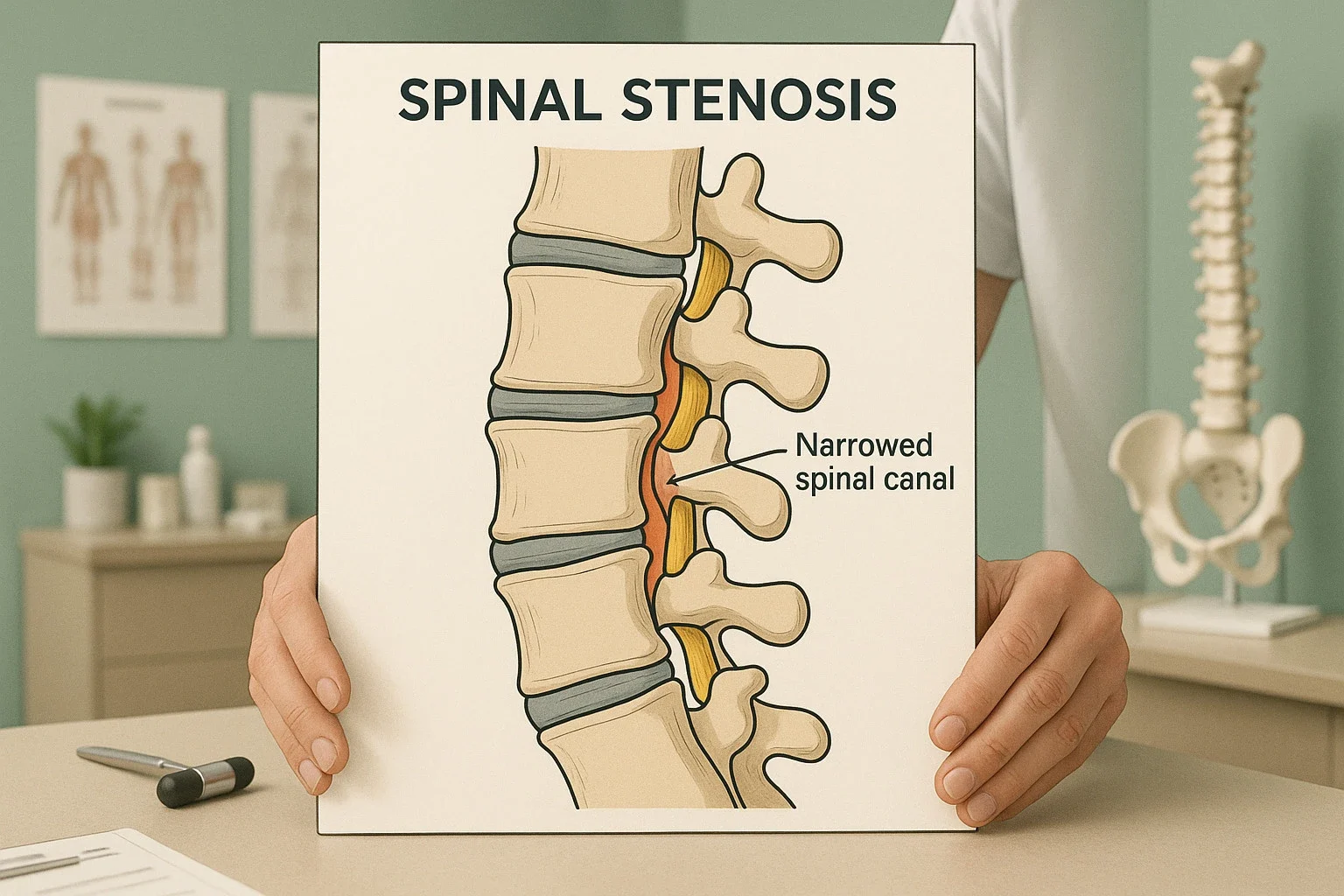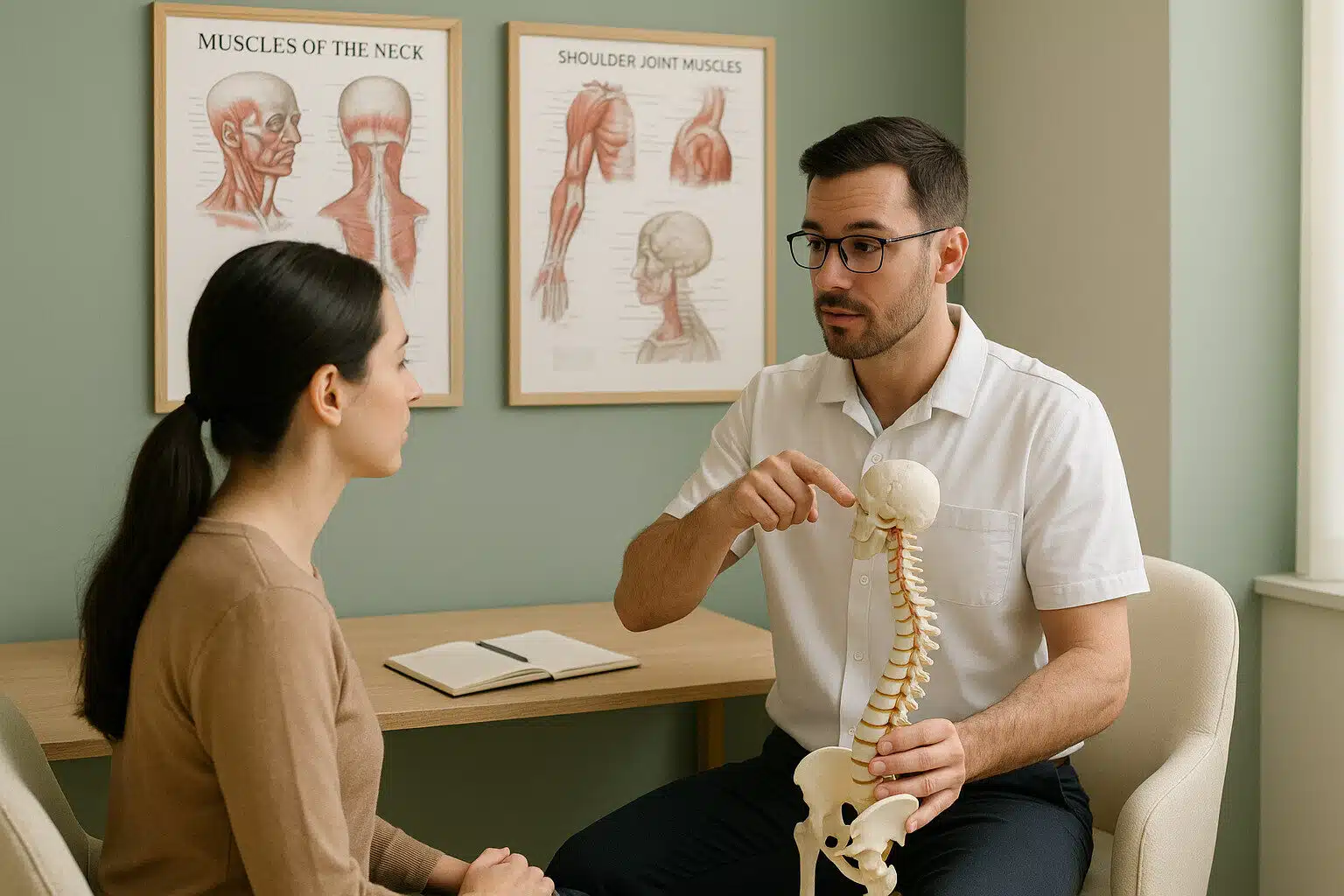Spinal stenosis affects millions of people, causing narrowing of the spinal canal that compresses nerves and creates pain, numbness, and mobility challenges [1]. When you face this condition, chiropractic care offers a non-invasive, holistic approach to managing your symptoms without relying solely on medications or surgery [2].
Understanding Spinal Stenosis
Spinal stenosis occurs when the spaces within your spine narrow, putting pressure on the nerves that travel through the spine [9]. This narrowing creates pain, weakness, or numbness in your legs, back, neck, or arms. The condition develops gradually over time and affects different areas of your spine [10].
Two primary types of spinal stenosis exist:
- Lumbar stenosis: Narrowing in the lower back, the most common form
- Cervical stenosis: Narrowing in the neck area
The condition typically results from age-related changes, including bone spurs, thickened ligaments, and disc degeneration [12]. These changes reduce the space available for your spinal cord and nerve roots.
How Chiropractic Care Addresses Spinal Stenosis
Chiropractic treatment for spinal stenosis focuses on addressing the underlying spinal misalignments that contribute to your symptoms [3]. Your chiropractor uses specific techniques to improve spinal mobility and reduce nerve compression without invasive procedures.
Key chiropractic approaches include:
Spinal Adjustments and Manipulation
Gentle spinal adjustments help restore proper alignment and reduce pressure on compressed nerves [1]. These precisely applied movements improve joint function and decrease inflammation around affected areas.
During my years treating patients with spinal stenosis in Brooklyn, I’ve found that consistent adjustments help many people experience significant symptom relief. One patient, a 68-year-old teacher, regained the ability to walk without pain after six weeks of targeted treatment.
Spinal Decompression Therapy
Decompression therapy gently stretches your spine, creating negative pressure within the discs [4]. This technique helps reduce pressure on pinched nerves and promotes better circulation to affected areas.
Flexion-Distraction Technique
This specialized method involves gentle flexing and stretching motions that help open up the spinal canals [15]. The technique proves particularly effective for lumbar spinal stenosis cases.
Evidence Supporting Chiropractic Treatment
Research demonstrates the effectiveness of chiropractic interventions for spinal stenosis management [13]. Studies show that patients receiving chiropractic care experience:
- Reduced pain levels
- Improved functional mobility
- Decreased reliance on pain medications
- Enhanced quality of life
A comprehensive review found that flexion-distraction manipulation therapy significantly reduced pain and disability in patients with lumbar spinal stenosis [19]. Another study comparing nonsurgical interventions showed promising results for manual therapy approaches [14].
While more research continues to establish long-term efficacy data, current evidence supports chiropractic care as a viable treatment option for many spinal stenosis patients [18].
For those dealing with related conditions, our sciatica treatment approaches often complement spinal stenosis care, as nerve compression issues frequently overlap.
Home Care Strategies
Your chiropractor will recommend specific home care strategies to support your treatment progress:
Flexion-Based Exercises
Exercises that promote spinal flexion help alleviate nerve compression [15]. These movements create more space within the spinal canals and reduce pressure on affected nerves.
Effective exercises include:
- Knee-to-chest stretches
- Pelvic tilts
- Seated flexion exercises
- Stationary bike riding
Heat and Cold Therapy
Alternating heat and cold applications provide symptom relief [16]. Heat therapy relaxes tight muscles and improves blood flow, while cold therapy reduces inflammation and numbs pain.
Apply heat for 15-20 minutes before activities and cold for 10-15 minutes after activities or when inflammation increases.
Ergonomic Modifications
Making ergonomic adjustments to your daily environment reduces spinal stress [17]. Focus on maintaining proper posture during sitting, standing, and sleeping.
Our comprehensive ergonomic desk setup guide provides detailed recommendations for workplace modifications that support spinal health.
Maintaining an Active Lifestyle
Staying active remains crucial for managing spinal stenosis symptoms. Low-impact activities help maintain spinal flexibility and strengthen supporting muscles without aggravating your condition.
Recommended activities include:
- Walking with forward-leaning posture
- Swimming or water exercises
- Recumbent cycling
- Yoga or tai chi
Professional guidance from your back pain relief specialist ensures you choose appropriate activities for your specific condition severity.
Key Takeaways
- Chiropractic care offers effective, non-invasive spinal stenosis treatment options
- Spinal adjustments and decompression therapy help reduce nerve compression
- Research supports chiropractic interventions for pain relief and improved function
- Home care strategies including flexion exercises and ergonomic modifications enhance treatment results
- Maintaining an active lifestyle supports long-term spinal health
Frequently Asked Questions
How effective is chiropractic treatment for spinal stenosis?
Research shows chiropractic care helps reduce pain, improve mobility, and decrease medication dependence in many spinal stenosis patients. Effectiveness varies based on condition severity and individual response to treatment.
What chiropractic techniques work best for spinal stenosis?
Flexion-distraction technique, spinal decompression, and gentle adjustments prove most effective. These methods create space within the spinal canals and reduce nerve pressure without aggressive manipulation.
How long does spinal stenosis chiropractic treatment take?
Treatment duration varies depending on symptom severity and individual healing response. Many patients notice improvement within 4-6 weeks, with continued progress over several months of consistent care.
Can chiropractic care prevent spinal stenosis surgery?
While not guaranteed, many patients avoid surgery through consistent chiropractic treatment combined with exercise and lifestyle modifications. Early intervention often produces better outcomes than waiting until symptoms become severe.
What exercises help with spinal stenosis at home?
Flexion-based exercises like knee-to-chest stretches, pelvic tilts, and stationary cycling help reduce symptoms. Your chiropractor will recommend specific exercises based on your condition and pain levels.
Is spinal stenosis chiropractic treatment safe?
Chiropractic treatment for spinal stenosis is generally safe when performed by licensed professionals. Gentle techniques minimize risks while providing effective symptom relief for most patients.
Ready to find relief? Schedule an appointment online or visit us at Brooklyn Chiropractic Care, 112 Greenpoint Ave. STE 1B, Brooklyn, NY 11222. Experience relief, Embrace Wellness!
References
- My Evolve Chiropractor. (2025). Can Chiropractic Help Spinal Stenosis?
- Saratoga Today. (2024). Chiropractic Care and Spinal Stenosis: A Holistic Approach to Managing the Condition.
- Summit Spine and Wellness. (2024). Chiropractic Care for Spinal Stenosis and Scoliosis.
- MCR Chiropractic. (2025). Treat Spinal Stenosis.
- NIAMS. (2023). Spinal Stenosis Symptoms, Causes, & Risk Factors.
- Mount Sinai. (2024). Spinal Stenosis Information.
- Cleveland Clinic. (2025). Spinal Stenosis: What It Is, Causes, Symptoms & Treatment.
- Snow, G.J. (2001). Chiropractic management of a patient with lumbar spinal stenosis.
- Schneider, M.J. et al. (2019). Comparative Clinical Effectiveness of Nonsurgical Interventions for Lumbar Spinal Stenosis.
- Lederman Chiropractic. (2021). Flexion-Based Exercises for Spinal Stenosis.
- Hinge Health. (2025). Spinal Stenosis Self-Care: Tips and Daily Habits.
- Spine-health. (2025). Living with Lumbar Spinal Stenosis.
- Stuber, K. et al. (2009). Chiropractic treatment of lumbar spinal stenosis: a review of the literature.
- Kim, S.H. et al. (2015). Effects of flexion-distraction manipulation therapy on pain and disability in patients with lumbar spinal stenosis.


